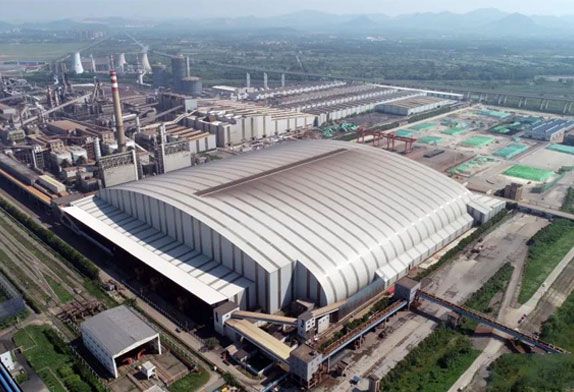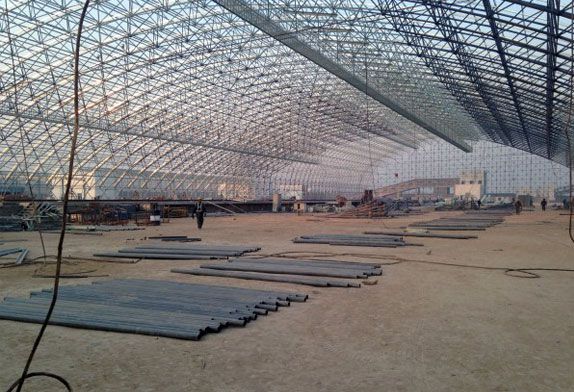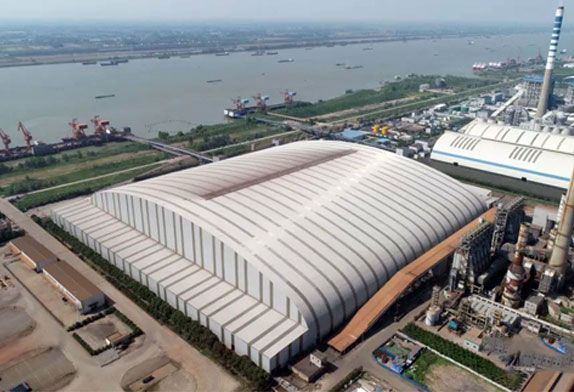
Steel structures or steel components are often used in thermal power plants, but the steel structures in different parts will be corroded differently, which will cause the quality of steel structures to decline, and as far as the current steel structures of thermal power plants are concerned, most of them lack Scientific and effective protective measures will reduce the service life of steel structures and increase the construction cost of thermal power plants. When carrying out corrosion protection for steel structures, the overall design of the steel structure and various important links must first be considered to ensure that the durability and usability of the steel structure can be effectively maintained. However, at present, the corrosion protection of steel structures is paid less attention to, which affects the overall safety performance of thermal power plants.
1.The harm of steel structure corrosion in thermal power plants
Steel structure corrosion is a kind of uneven damage. Once corrosion occurs on the surface of the steel structure, it will erode into the interior of the steel structure, resulting in stress concentration, which will further accelerate corrosion. Under the influence of this kind of chain reaction, the cold and brittle resistance of steel will continue to decline, which will affect the overall quality of steel, and load-bearing steel will have brittle fracture without warning, which will lead to the collapse of buildings and affect people’s lives. Long-term corrosion of steel structure will lead to brittle fracture of steel, which will affect the overall building strength and bring serious safety hazards. At present, thermal power plants pay less attention to the corrosion of steel structures, which makes the service life of some equipment shorter, and even frequent maintenance, resulting in high-cost investment and poor equipment application effect. Moreover, safety accidents caused by the corrosion of steel structures in thermal power plants will affect the smooth operation of thermal power plants.
2. Analysis of steel structure corrosion factors
(1) Poor environmental conditions
The steel structure in the basement of the thermal power plant is in a harsh environment, and the basement is prone to water accumulation, which will seriously corrode the steel structure, which in turn will cause serious corrosion at the foot of the column. Especially for the coal conveying system, a large amount of water is needed during operation, which in turn causes the overall environmental humidity to be high, which affects the service life of the anti-corrosion coating and causes the fire-proof coating to fall off. In this case, the steel structure is also will be severely corroded. However, power plants located in some coastal areas, due to long-term erosion by sea wind, will easily lead to chalking and peeling off of anti-corrosion coatings.
(2)unreasonable design
According to the investigation factors of corrosion problems in thermal power plants and the construction drawings and installation instructions of steel structures, it is found that steel structure materials are generally coated with epoxy anti-corrosion coatings when they leave the factory, and two primers and two top coats are added at the same time. The coating thickness is 150 μm for the structure and 125 μm for the interior. This shows that when selecting anti-corrosion coatings, scientific and reasonable coatings were not selected according to the corrosive environment, and the dry film thickness and service life of the relevant coatings were not reasonably designed; and for indoor and outdoor environments, there is no specific distinction between epoxy coatings. Anti-corrosion coatings and polyurethane-based topcoats; in the long-term anti-corrosion process, inorganic zinc-rich primers are not preferred. If the outdoor environment of the industrial park is poor, epoxy anti-corrosion coatings cannot have a strong effect and are prone to chalking. According to the survey, most of the thermal power plants in the industrial park have a coating thickness of 150 μm, and this method has a relatively low anti-corrosion period. For outdoor steel escalators, patterned steel plates are mainly used as steps, but the applied anti-corrosion materials are often not firm, and even water will appear. Since some steel escalators are close to the building body, and the distance between the steel frame and the building body is relatively close, there is not enough space, so it cannot be effectively maintained and can only be allowed to corrode. As for the column feet of the steel structure, the drainage holes are not considered comprehensively, and corrosion will also occur if the rainwater is soaked for a long time. If this type of pipe frame chooses to use angle steel combined diagonal braces, and there is a certain gap between the two, it cannot be effectively maintained, and yellow rust will appear under the washing of rainwater.
(3)Poor construction control
When coating the steel structure, the quality control of the whole process is not in place, and the coating thickness is not checked in time, which leads to corrosion of the steel structure in a short period of time. Due to the requirements of steel structure design and processing technology, the overall thickness of the primer and topcoat should not be less than 100μm, and when the last topcoat is painted, it needs to be painted after fixing. Under normal circumstances, the steel structure factory will send special supervisors to check the actual situation of the anti-corrosion work, and then complete the acceptance, but in the actual process, the staff ignores the link of coating thickness and quality, which makes the whole process lack of supervision and management. For example, when performing anti-corrosion work on the structure of a step-up substation, thermal spraying of zinc is usually used. This method is less used in industry and has a higher labor intensity, especially for steel pipes with rounded surfaces. In terms of structure, it is difficult to effectively control the hot-dip galvanizing process. In addition, because the overall thickness of the zinc layer is not uniform, it is prone to corrosion, and most of them are still hot-dip galvanized for protection.\

3. Protection measures for steel structures in thermal power plants
(1) Coating method
At present, more than 90% of the steel structures in thermal power plants adopt the coating protection method as the main anti-corrosion measure for steel structures. The coating method can effectively isolate the corrosive environment. There are many kinds of coating protection methods, including ordinary coating protection and long-term coating protection. Long-term coating protection is mainly sprayed metal layer protection. Long-term coating protection methods are better than ordinary coating protection methods. Effective isolation of corrosive environments. At present, compared with the outdoor steel structure of the indoor steel structure of thermal power plants, the protection of the indoor steel structure is more convenient and the cost is lower. The protection of the outdoor steel structure requires a lot of costs, and the overall effect is not as good as the anti-corrosion effect of the indoor steel structure. powerful. When using the coating method, the first step is to remove the rust on the surface of the steel structure. Only by ensuring the surface gloss of the steel structure can the effect of the coating be ensured. Therefore, sandblasting and shot peening are generally used for coatings with higher requirements. The next step of construction can only be carried out after the metal has removed all rust and oil stains to expose the surface luster, and the rust removal method for on-site construction can be manually deducted. For example, the steel structure and equipment of a company were severely corroded, which greatly reduced the strength of the steel structure. This is due to the special geographical location of the company, which has abundant rainfall throughout the year and faces strong monsoons for 6 months every year, which will cause the steel structure to adhere to humid air, and such moisture is highly corrosive. Especially for boilers and pipelines in the factory, due to the influence of air convection, the corrosion of this equipment is often more serious than indoors. Therefore, when applying the coating method, the surrounding environment must first be considered comprehensively. Different coatings have different corrosion conditions. The general coating method is mainly divided into the primer coating and topcoat coating. The primer coating contains more powder. , it is relatively rough after film formation, but the overall adhesion of the steel structure is strong, and the overall effect can be improved by combining it with the topcoat; while the topcoat coating has a large dose, it is generally smooth after film formation and has weathering resistance features. The compatibility between different coatings also needs to be studied, and the compatibility of the two needs to be considered comprehensively when selecting materials. At the same time, the temperature and humidity of coating construction should be controlled to ensure that the temperature is above 5°C and within 38°C, and the humidity should not be higher than 85%. After finishing the coating, it is guaranteed that it will not be exposed to rain within 4 hours. After the coating is air-dried, it is generally 150 μm outdoors and 125 μm indoors. If the thermal power plant is located on the seashore or offshore, it is necessary to comprehensively consider the strong corrosiveness of the atmosphere, and the coating should be controlled within 200-220μm.
(2) Hot-dip galvanizing
The hot-dip galvanizing method is to immerse the rust-removed steel structure into a high-temperature zinc solution of 600°C so that the zinc solution can adhere to the surface of the steel structure. For thin plates below 5mm, the thickness of the zinc layer should be controlled above 65μm, and for thick plates It can not be lower than 86μm, and then play a role in anti-corrosion. Using this method can effectively extend the life of the steel structure, and its industrialization degree is relatively high, the overall quality is relatively stable, and it is more conducive to the corrosion resistance of the steel structure. Therefore, this method can be selected for some outdoor steel structures that are severely corroded or difficult to maintain. With the rapid development of the current thermal spraying process, thermal spraying coating technology has been fully applied, and the current thermal spraying technology has developed to superimposed spraying, which means spraying a layer as the bottom layer first, and then spraying aluminum-zinc alloy; or you can first Spray new aluminum alloy, and then spray stainless steel on the surface.
(3) Weathering steel
Weathering steel means that its corrosion resistance is higher than that of ordinary steel structures. It is mainly composed of various metal factors such as phosphorus, nickel, and peptide. Through the application of several metals, a protective layer can be formed on the surface to effectively strengthen the steel structure. corrosion resistance. Moreover, the low-temperature impact toughness of weathering steel is higher than that of general steel structures. Compared with ordinary carbon steel, weathering steel has good radiation resistance in the air; compared with stainless steel, its content of alloy elements is lower, so weathering steel belongs to the low alloy steel between ordinary carbon steel and stainless steel. Weather-resistant steel is more suitable for environments exposed to atmospheric conditions for a long time. When using weather-resistant steel, the use of anti-corrosion coatings can be reduced accordingly, which can effectively save economic costs and reduce environmental pollution. In climatic conditions with a low degree of corrosion, weathering steel can be used bare, and in environments with strong corrosion, weathering steel can be used with coatings.

4. Precautions for steel structure corrosion
In order to ensure the anti-corrosion durability of the steel structure, it is necessary to avoid the use of combined steel components in the environment of direct rain. At the same time, it is also necessary to prevent corrosion of dead corners to prevent the steel components from forming water areas, and strengthen waterproofing. Due to the installation of fans and other equipment on the steel structure of the air-cooled platform, the overall construction space is limited, which increases the difficulty of overall maintenance. In this case, hot-dip galvanizing is generally used, and anti-corrosion coating can also be applied to extend the use of the steel structure. life. For structures such as step-up substations, thermal spraying zinc can generally be used. Its overall performance is strong, but it requires more energy from workers, especially for steel structures with curved steel pipe surfaces. The overall construction is difficult, and it is difficult to meet the anti-corrosion requirements of the steel structure only by thermal spraying zinc, so it is necessary to simultaneously increase the anti-corrosion topcoat. If the thickness of hot-dip galvanizing exceeds 80 μm, it needs to be galvanized in two parts, but this situation will cause uneven color, so cold spray galvanizing can be used.
For thermal power plants, it is of great significance to strengthen the corrosion protection of steel structures, which can not only improve the overall safety performance of thermal power plants but also effectively ensure their economic benefits. Therefore, the corrosion protection of steel structures should be paid attention to in the structural design of thermal power plants. The corrosion performance of steel structures can be strengthened through a reasonable selection of anti-corrosion materials and analysis of construction techniques. At the same time, when selecting steel structures, it is also necessary to formulate corresponding protection plans according to the actual conditions of thermal power plants to ensure the anti-corrosion performance of steel structures.











 About Us
About Us 2023-04-17
2023-04-17


